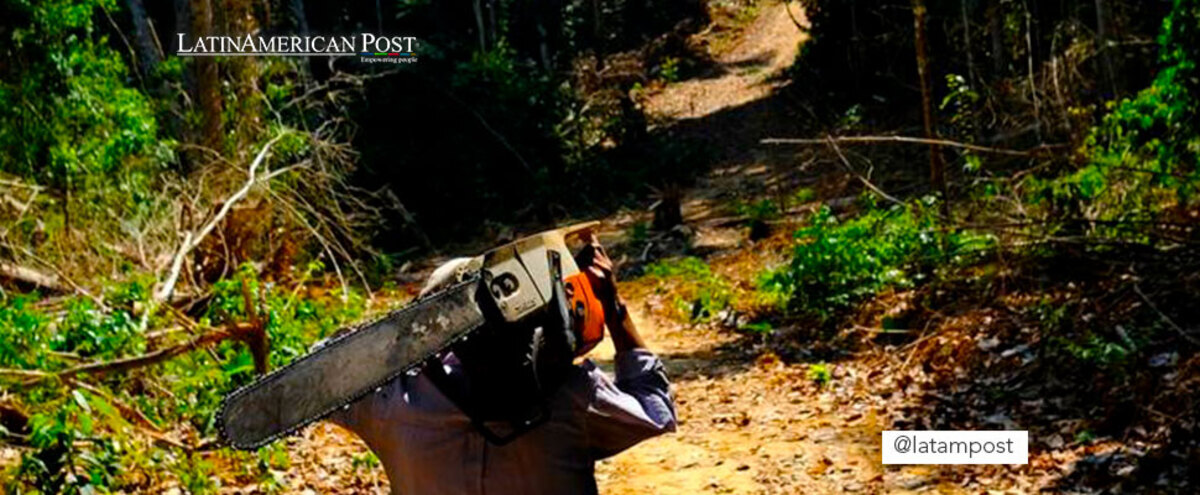What Happens With the Smuggling of Wood in the Amazon Countries?
Wood smuggling or illegal timber trade is one of the major causes of deforestation in countries that have part of the Amazon. In this article, we address this phenomenon and its projections.

Photo: Reuters
LatinAmerican Post | María Fernanda Ramírez Ramos
Escucha este artículo
Leer en español: ¿Qué sucede con el contrabando de madera en los países amazónicos?
Latin America and the Caribbean is home to around half of the planet's biodiversity. For this reason, its abundant forests have been a source of timber, both legal and illegal, for the world. Wood smuggling is a threat to the Amazon because it is driving its accelerated deforestation. The World Wide Fund for Nature (WWF) points out that the illegal timber business represents between 50 and 160 billion dollars a year.
9 Amazon countries: none is spared from timber smuggling
When you think of the Amazon, it is often associated with Brazil, Colombia, or Peru. However, this enormous lung of the world, of approximately 7 million square kilometers, is part of 9 different countries. One of the most in-depth investigations into the illegal timber trade in the region in recent years was carried out by the International Criminal Police Organization INTERPOL. This organization points out that "crimes against the environment are the third most frequent form of transnational organized crime in the world."
With the support of other local and international organizations, INTERPOL carried out a police operation in 2022 to detect criminal networks related to forest crimes. "Information gathered during Operation Arcadia LAC shows that illegal logging is occurring at an alarming rate in some of the world's most valuable reserves of biodiversity," said Ilana de Wild, who heads INTERPOL's Organized Crime and New Criminal Trends, in a statement from the institution. One of her conclusions is that the networks are not national, but that different actors are interconnected.
We recommend you read: Gallery: 10 Nature Restoration Initiatives Featured at COP15
In this regard, the Amazonia Viva 2022 report states that: "In Brazil, illegal logging in the Amazon supplies more wood to the market than the legal one; 47 percent of the wood sold in Colombia is illegal and part of it comes from Amazon forests in Peru, is legalized in Colombia and sold in Brazil".
Likewise, regarding Ecuador, this report indicates that between 2019 and 2020, raft exports doubled, reaching a value of 550 million dollars. However, this threatened protected areas and reduced the availability of rafts by 75% within the Ecuadorian Amazon. This country has 95% of the raft exports in the world. However, WWF also found that these profits do not have an impact on the local economy and the improvement of the quality of life of those who live in the exploited areas, especially indigenous people. In Peru, the Forest Supervision Agency (OSINFOR) found that in 2018 around 4,000 cubic meters of shihuahuaco were extracted illegally. It is a type of wood that is widely purchased in China for the manufacture of floors.
On the other hand, they use techniques that make it difficult to track down those who commit these crimes. "For example, in many territories what illegal actors do is launder the wood, that is, they use legal permits to take advantage of and transport wood of species extracted from areas without permits," explained Johana Herrera, WWF Colombia Forestry Officer, in a statement from that organization.
What should be done to regulate the timber trade?
It is true that wood is a renewable resource. However, if there is an overexploitation or bad practices with the soils, an irreparable affectation is made to the ecosystems. For this reason, there must be strict regulations that ensure that the timber market is sustainable. This implies that only certain species can be exploited in determined areas and under specific cycles.
The WWF's Living Amazon 2022 report points out that it is urgent to create joint actions between the governments of the region to deal with timber smuggling, since it is cross-border in nature. "Among the main actions to face this threat is the promotion of a legal timber market through the implementation of timber traceability technologies and certification schemes such as FSC. A well-conducted timber trade has the potential to conserve forests and, at the same time, provide sustainable livelihoods for local populations".
Despite the fact that timber smuggling is a business that has reached worrying levels, there are also good practices and initiatives that aim to regulate the timber trade and curb illegal logging. In fact, the eyes of the world are on Brazil today, as the new president, Lula da Silva, and his minister Marina Silva are expected to implement agile and effective plans to curb deforestation.
For its part, Colombia has the Intersectoral Pact for Legal Timber in Colombia, which has a catalog of responsible timber companies. In addition, projects with artificial intelligence are being carried out to monitor wood with a program called XyloTron, according to information from WWF.
Buyer's responsibility
If the illegal timber business prospers, it is because there is a demand. However, in the face of humanity's looming climate and environmental crisis, it is a collective responsibility to protect forests. In this sense, the work of protection against deforestation also implies that the countries that buy wood from Latin America have strict regulations on what type of wood they buy.
In this regard, the European Union agreed in December 2022 to create a new regulation to tighten controls and regulations regarding seven products that are considered to have contributed to deforestation. This includes palm oil, cocoa, soybeans, coffee and cattle, as foodstuffs, and wood and rubber, in industrial products. Likewise, it includes the derivatives that come out of these products.





